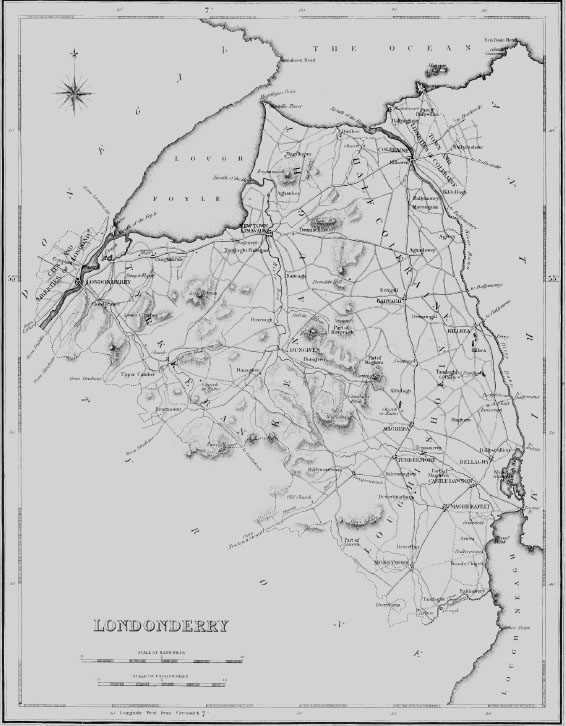| Accompanying Lewis map for Derry 
|
| ERRIGAL |
| ERRIGAL, or ARRIGLE, a parish, in the barony of COLERAINE, county of LONDONDERRY, and province of ULSTER ; containing, with the post-town of Garvagh (which is described under its own head), 5401 inhabitants. A monastery was founded here by St. Columb in 589, which flourished until the ninth century, when it was plundered and destroyed by the Danes, The parish is bounded on the south by the Agivey water, and comprises, according to the Ordnance survey, 19,625- statute acres, of which 18,113 are applotted under the tithe act and valued at £5163 per ann. ; about 7500 acres are arable, 5500 pasture, 100 woodland, and the remainder bog and mountain ; the latter affording good pasturage to large herds of cattle. The vale of Glenullen, and all the lands around Garvagh and on the banks of the Agivey water, are fertile, and even many of the more elevated lands produce excellent crops, though agriculture has been but little improved. The mountain range consists principally of the eastern slopes of Ballyness and Donald's hill, extending to the boundary of the barony, and are exclusively basalt, but everywhere produce sweet herbage. The inhabitants unite with agriculture the weaving of linen cloth. There are several handsome houses in the parish, the principal of which are Garvagh, the seat of Lord Garvagh, adjoining which is the picturesque vale of Glenullen ; Ballintemple, of Mrs. Arthur Heyland ; Woodbank, of Capt. Orr ; Garvagh Cottage, of Capt. Crossley ; and Meetigan glebe-house, of the Rev. W. Smith. The living is a rectory, in the diocese of Derry, and in the patronage of the Bishop : the tithes amount to £353, of which £300 are payable to the rector, the percentage to the landlord being about £53. The glebe-house, a small old building, is delightfully situated near the top of Glenullen ; the glebe comprises about 254 acres. The church is a low plain building, adjoining the town of Garvagh, to the repairs of which the Ecclesiastical Commissioners have recently made a grant of £201. In the R. C. divisions this parish is the head of a union or district, comprising also parts of Desertog hill and Balteagh, and containing two chapels, one at Ballerin, and the other in Glenullen. There are places of worship in Garvagh for Presbyterians in connection with the Synod of Ulster and the Seceding Synod, and for Separatists from the Seceding Synod, also one for Wesleyan Methodists. There are parochial and five other public schools, some of which are aided by donations from Lord Garvagh, R. McCausland, Esq., Mrs. Heyland, the rector, and the Ironmongers' Company ; they afford instruction to about 400 children. A school founded by Dr. Adam Clarke is supported by the Wesleyan Methodists ; and about 120 children are educated in four private schools. Here are numerous forts, particularly in Glenullen, evidently constructed to protect the pass into the mountains. The old church at Ballintemple is a very interesting ruin. The Rev. G. V. Sampson, author of the Map and Memoir of Londonderry, and the Statistical Survey of the same county, was rector of this parish, and died at the glebe-house ; he was buried at Aghanloo. |
| GARVAGH |
| GARVAGH, a market and post-town, in the parish of ERRIGAL, barony of COLERAINE, county of LONDONDERRY, and province of ULSTER, 8 miles (S.) from Coleraine, and 110? (N. by W.) from Dublin, on the road from Armagh to Coleraine : the population is returned with the parish. It appears to have been a place of some importance soon after the plantation of Ulster. In 1641, Col. Rowley raised a regiment of foot and marched into the town for its protection. After keeping possession of it for some time, he was attacked by a party of forces commanded by Sir Phelim O'Nial, who, making themselves masters of the place, put the Colonel and many of the inhabitants to death, burnt the town, and plundered the country to the very gates of Coleraine. The town consists of one long spacious street intersected at right angles by two smaller streets ; many of the houses are large and handsomely built, and the whole has an appearance of great respectability. Adjoining it is Garvagh House, the seat of Lord Garvagh, a spacious mansion with a well-planted demesne and an extensive park ; and there are several other gentlemen's seats, which are noticed in the article on the parish. The trade of the place is considerable, and with the town owes its prosperity to the Canning family. The market is on Friday and is well supplied ; and on the third Friday in every month a fair is held for the sale of brown linen, horses, cattle, sheep, and pigs, each of which is numerously attended. Petty sessions are held in a court-house on the last Monday of every month. Adjoining the town is the parish church, a small neat edifice ; and there is a meeting-house for Presbyterians in connection with the Synod of Ulster, of the second class, built in 1746, rebuilt in 1790, and enlarged in 1830 ; another in connection with the Seceding Synod, and a third for Separatists from that synod. |
|